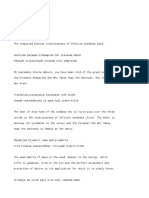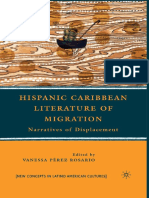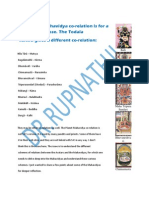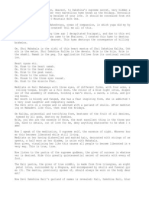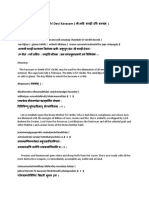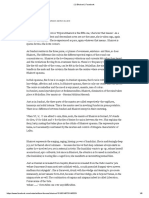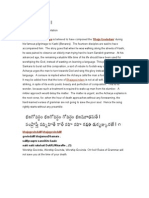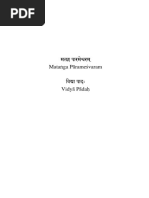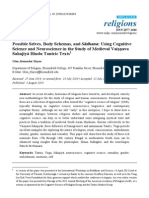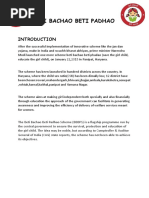0 ratings0% found this document useful (0 votes)
266 viewsChinnamasta
Chinnamasta
Uploaded by
Pradyot RoyChinnamasta is a Hindu goddess who is depicted as a naked woman who has severed her own head with a sword. Three jets of blood spurt from her neck, one of which enters her own mouth in her severed head, while the other two streams enter the mouths of her two female associates. The document describes the origin story of Chinnamasta, in which the goddess Parvati severs her own head to provide food for her hungry attendants. It also discusses the symbolism and interpretations of Chinnamasta's iconography, in which she stands atop the copulating figures of Kama and Rathi, representing either the defeat of sexual desire or the embodiment of sexual energy.
Copyright:
© All Rights Reserved
Available Formats
Download as DOCX, PDF, TXT or read online from Scribd
Chinnamasta
Chinnamasta
Uploaded by
Pradyot Roy0 ratings0% found this document useful (0 votes)
266 views2 pagesChinnamasta is a Hindu goddess who is depicted as a naked woman who has severed her own head with a sword. Three jets of blood spurt from her neck, one of which enters her own mouth in her severed head, while the other two streams enter the mouths of her two female associates. The document describes the origin story of Chinnamasta, in which the goddess Parvati severs her own head to provide food for her hungry attendants. It also discusses the symbolism and interpretations of Chinnamasta's iconography, in which she stands atop the copulating figures of Kama and Rathi, representing either the defeat of sexual desire or the embodiment of sexual energy.
Original Description:
Chinnamasta
Copyright
© © All Rights Reserved
Available Formats
DOCX, PDF, TXT or read online from Scribd
Share this document
Did you find this document useful?
Is this content inappropriate?
Chinnamasta is a Hindu goddess who is depicted as a naked woman who has severed her own head with a sword. Three jets of blood spurt from her neck, one of which enters her own mouth in her severed head, while the other two streams enter the mouths of her two female associates. The document describes the origin story of Chinnamasta, in which the goddess Parvati severs her own head to provide food for her hungry attendants. It also discusses the symbolism and interpretations of Chinnamasta's iconography, in which she stands atop the copulating figures of Kama and Rathi, representing either the defeat of sexual desire or the embodiment of sexual energy.
Copyright:
© All Rights Reserved
Available Formats
Download as DOCX, PDF, TXT or read online from Scribd
Download as docx, pdf, or txt
0 ratings0% found this document useful (0 votes)
266 views2 pagesChinnamasta
Chinnamasta
Uploaded by
Pradyot RoyChinnamasta is a Hindu goddess who is depicted as a naked woman who has severed her own head with a sword. Three jets of blood spurt from her neck, one of which enters her own mouth in her severed head, while the other two streams enter the mouths of her two female associates. The document describes the origin story of Chinnamasta, in which the goddess Parvati severs her own head to provide food for her hungry attendants. It also discusses the symbolism and interpretations of Chinnamasta's iconography, in which she stands atop the copulating figures of Kama and Rathi, representing either the defeat of sexual desire or the embodiment of sexual energy.
Copyright:
© All Rights Reserved
Available Formats
Download as DOCX, PDF, TXT or read online from Scribd
Download as docx, pdf, or txt
You are on page 1of 2
The sixth Goddess among the Mahavidyas is Sri Chinnamasta, also known as
Chinnamastaka. She is the goddess of courage and discernment. The literal
meaning of the word Chinnamasta is one with a severed head. She is
traditionally portrayed as a naked or scantily dressed woman astride the bodies,
in intimate position, of Kama (Hindu god of love and sexual lust), and his wife
Rathi. Chinnamasta, having severed her own head with her own sword, holds
her severed head on one of her hands. Three jets of blood spurt out of her
bleeding neck, and one streams into her own mouth of her severed head, while
the other two streams into the mouths of her two female associates.
One day Parvati went to bathe in the Mandakini River with her two attendants,
jaya and Vijaya. After bathing, the great goddess's colour became black
because she was sexually aroused. After some time, her two attendants
asked her, "Give us some food. We are hungry." She replied, "I shall give you
food but please wait." After awhile, again they asked her. She replied, "Please
wait, I am thinking about some matters." Waiting awhile, they implored her,
"You are the mother of the universe. A child asks everything from her mother.
The mother gives her children not only food but also coverings for the body. So
that is why we are praying to you for food. You are known for your mercy;
please give us food." Hearing this, the consort of Shiva told them that she
would give anything when they reached home. But again her two attendants
begged her, "We are overpowered with hunger, O Mother of the Universe. Give
us food so we may be satisfied, O Merciful One, Bestower of Boons and
Fulfiller of Desires." Hearing this true statement, the merciful goddess smiled
and severed her own head. As soon as she severed her head, it fell on the
palm of her left hand. Three bloodstreams emerged from her throat; the left
and right fell respectively into the mouths of her flanking attendants and the
center one fell into her mouth. After performing this, all were satisfied and later
returned home. (From this act) Parvati became known as Chinnamasta.
In visual imagery, Chinnamasta is shown standing on the copulating couple of
Kamadeva and Rathi, with Rathi on the top. They are shown lying on a lotus.
There are two different interpretations of this aspect of Chinnamasta's
iconography. One understands it as a symbol of control of sexual desire, the
other as a symbol of the goddess's embodiment of sexual energy. The most
common interpretation is one where she is believed to be defeating what
Kamadeva and Rathi represent, namely sexual desire and energy. In this
school of thought she signifies self-control, believed to be the hallmark of a
successful yogi. The other, quite different interpretation states that the
presence of the copulating couple is a symbol of the goddess being charged by
their sexual energy. Just as a lotus seat is believed to confer upon the deity
seated atop it's qualities of auspiciousness and purity, Kamadeva and Rathi
impart to the Goddess standing over them the power and energy generated by
their lovemaking. Gushing up through her body, this energy spouts out of her
headless torso to feed her devotees and also replenish herself. Significantly
here the mating couple is not opposed to the goddess, but an integral part of
the rhythmic flow of energy making up the Chinnamasta icon. The image of
Chinnamasta is a composite one, conveying reality as an amalgamation of
sex, death, creation, destruction and regeneration. It is stunning representation
of the fact that life, sex, and death are an intrinsic part of the grand unified
scheme that makes up the manifested universe. The stark contrasts in this
iconographic scenario-the gruesome decapitation, the copulating couple, the
drinking of fresh blood, all arranged in a delicate, harmonious pattern - jolt the
viewer into an awareness of the truths that life feeds on death, is nourished by
death, and necessitates death and that the ultimate destiny of sex is to
perpetuate more life, which in turn will decay and die in order to feed more life.
As arranged in most renditions of the icon, the lotus and the pairing couple
appear to channel a powerful life force into the goddess. The couple enjoying
sex convey an insistent, vital urge to the goddess; they seem to pump her with
energy. And at the top, like an overflowing fountain, her blood spurts from her
severed neck, the life force leaving her, but streaming into the mouths of her
devotees (and into her own mouth as well) to nourish and sustain them. The
cycle is starkly portrayed: life (the couple making love), death (the decapitated
goddess), and nourishment (the flanking yoginis drinking her blood).
You might also like
- Introduction To Sanskrit Part 1 - Thomas EgenesDocument404 pagesIntroduction To Sanskrit Part 1 - Thomas EgenesDevlinPyx100% (6)
- Chapter 6-10 The Ratcatchers DaughterDocument2 pagesChapter 6-10 The Ratcatchers DaughterMinaliNo ratings yet
- Mineral Claim Purchase and Sale Agreement FinalDocument5 pagesMineral Claim Purchase and Sale Agreement Finaldaks4uNo ratings yet
- Carolyn Gage VitaeDocument31 pagesCarolyn Gage Vitaecarolyn6302No ratings yet
- Kali KavachDocument6 pagesKali KavachrudraNo ratings yet
- Sankalp MantraDocument1 pageSankalp MantraPradyot Roy100% (2)
- Shiv Stuti MantraDocument3 pagesShiv Stuti MantraPradyot Roy67% (3)
- (New Concepts in Latino American Cultures) Vanessa Pérez Rosario (Eds.) - Hispanic Caribbean Literature of Migration - Narratives of Displacement-Palgrave Macmillan US (2010)Document246 pages(New Concepts in Latino American Cultures) Vanessa Pérez Rosario (Eds.) - Hispanic Caribbean Literature of Migration - Narratives of Displacement-Palgrave Macmillan US (2010)Irene Gutiérrez100% (2)
- Ambigai and DasavatharamDocument17 pagesAmbigai and DasavatharamShankarr KshanNo ratings yet
- Chinnamasta 1Document3 pagesChinnamasta 1ababa_ababa5256No ratings yet
- Ardhanarishvara Stotra: A Hymn on Unified Form Of Shiva and Shakti by Shankara BhagavadpaadaFrom EverandArdhanarishvara Stotra: A Hymn on Unified Form Of Shiva and Shakti by Shankara BhagavadpaadaNo ratings yet
- Goddess Chinnamasta, The One With The Severed HeadDocument4 pagesGoddess Chinnamasta, The One With The Severed HeadAmbrish GuptaNo ratings yet
- Chinna Mast ADocument4 pagesChinna Mast AdenramrNo ratings yet
- Meditation On Lalita: Tripurasundari Lalita Hindu Tantrik Translations OnlineDocument4 pagesMeditation On Lalita: Tripurasundari Lalita Hindu Tantrik Translations Onlinenischalala100% (1)
- Sri Devi Khadgamala Stotram EnglishDocument4 pagesSri Devi Khadgamala Stotram Englishextra_hack@yahoo.comNo ratings yet
- BibbyDocument8 pagesBibbyjaya2504No ratings yet
- Lopamudra AcharaDocument4 pagesLopamudra AcharaApte SatishNo ratings yet
- The Heart of KaliDocument2 pagesThe Heart of KaliAlejandro MachucaNo ratings yet
- Śrī Vārāhī Devi Kavaca IAST and Devanagari MixedDocument5 pagesŚrī Vārāhī Devi Kavaca IAST and Devanagari MixedRN100% (1)
- Vamachara: Pashu-Bhâva (Animal) Is Characterized by A VeryDocument3 pagesVamachara: Pashu-Bhâva (Animal) Is Characterized by A VeryAdamLBrinklowNo ratings yet
- The Soma TantraDocument95 pagesThe Soma TantraCristina Comaniciu100% (1)
- Ugra Tara or MahaChina TaraDocument2 pagesUgra Tara or MahaChina TaraAnand SharmaNo ratings yet
- Chinnamasta: Compiled byDocument2 pagesChinnamasta: Compiled bysmiles789No ratings yet
- Sri Maha Pratyangira DeviDocument2 pagesSri Maha Pratyangira DeviSuresh Sivakumar0% (1)
- Bhairavi - FacebookDocument8 pagesBhairavi - FacebookMislioc TragateljNo ratings yet
- Abhinav Gupt - Bhairav StotraDocument6 pagesAbhinav Gupt - Bhairav StotraArun Sharma100% (2)
- AtharvavedinsDocument127 pagesAtharvavedinsKNagarajuKNo ratings yet
- Curse Removal Mantras of Dakshinakālī and ChinnamastāDocument4 pagesCurse Removal Mantras of Dakshinakālī and ChinnamastāsrimatsimhasaneshwarNo ratings yet
- Maha Ganapati HomamDocument40 pagesMaha Ganapati Homamkrishvidhya2000No ratings yet
- Shri Shakti MahimnaDocument13 pagesShri Shakti MahimnaAlejandro MachucaNo ratings yet
- BhairaviDocument1 pageBhairaviPradyot Roy100% (1)
- Devi Mahatmya and VarahiDocument2 pagesDevi Mahatmya and VarahikrishnaNo ratings yet
- Shri Bagla Tantra English 1Document2 pagesShri Bagla Tantra English 1KNagarajuK100% (1)
- 05chinmasta Mantra SadhanDocument3 pages05chinmasta Mantra SadhanPrabhavathi Ayyagari100% (1)
- Aghori Ascetics PDFDocument3 pagesAghori Ascetics PDFKaustubh Keskar100% (1)
- Radhika Tapaniyopanishadas12345Document7 pagesRadhika Tapaniyopanishadas12345Samvit Mahashay75% (4)
- Devi MahatmyaDocument10 pagesDevi MahatmyaZoth BernsteinNo ratings yet
- Ucchista Ganapati AshtotramDocument22 pagesUcchista Ganapati Ashtotramakshay patriNo ratings yet
- The Sacred Mahakala in The Hindu and Buddhist Texts: Dr. Poonam R L RanaDocument18 pagesThe Sacred Mahakala in The Hindu and Buddhist Texts: Dr. Poonam R L RanaAdi Tri GunawanNo ratings yet
- Srividya Chakras RegimeDocument2 pagesSrividya Chakras RegimeJatin YadavNo ratings yet
- 014 Saptha Mathas PDFDocument10 pages014 Saptha Mathas PDFSATYA PRIYA ROUTNo ratings yet
- Aghori Babas in IndiaDocument8 pagesAghori Babas in IndiaAnimesh GuptaNo ratings yet
- Apsara Sadhna: MONDAY, MARCH 1, 2010Document1 pageApsara Sadhna: MONDAY, MARCH 1, 2010Sonu Jaiswal100% (1)
- Various Ganesha MantraDocument95 pagesVarious Ganesha MantraRajivNo ratings yet
- Ganapati AtharvashirshaDocument16 pagesGanapati AtharvashirshaPhonetics laboratoryNo ratings yet
- 7 Shakti Peethas MapDocument1 page7 Shakti Peethas Maprajan35No ratings yet
- Bija MantraDocument2 pagesBija MantrakoolwaterNo ratings yet
- Vdocuments - MX - Batuk Bhairav 101 Mantras PDFDocument1 pageVdocuments - MX - Batuk Bhairav 101 Mantras PDFShaktha Anand NathNo ratings yet
- BHAJA GOVINDAM Tranlation With Telugu ScriptDocument12 pagesBHAJA GOVINDAM Tranlation With Telugu Scriptmadhuv3No ratings yet
- Matanga Agama Vidya PadaDocument78 pagesMatanga Agama Vidya PadaBimalKrishnaNo ratings yet
- G.A. Hayes, Vaisnava SahajiyaDocument16 pagesG.A. Hayes, Vaisnava Sahajiyanandana11100% (1)
- Starter RegimeDocument2 pagesStarter Regimevssmonroe100% (1)
- Navarathri Malar 1994 1Document13 pagesNavarathri Malar 1994 1SaravanapriyanSriraman100% (3)
- Dehasta-Devata-cakra StrotraDocument4 pagesDehasta-Devata-cakra Strotraakshay patri100% (1)
- Tara Astak, in English and TranslationDocument3 pagesTara Astak, in English and TranslationPradyot Roy100% (1)
- Dasha Maha VidyaDocument9 pagesDasha Maha Vidyayish ChaudhariNo ratings yet
- Ujjain TantraDocument3 pagesUjjain Tantrasriramnayak100% (1)
- The Avatar Faculty: Ecstatic Transformations in Religion and Video GamesFrom EverandThe Avatar Faculty: Ecstatic Transformations in Religion and Video GamesNo ratings yet
- The Book Changer: The Life & Teachings of HH Jayadvaita SwamiFrom EverandThe Book Changer: The Life & Teachings of HH Jayadvaita SwamiNo ratings yet
- शिवमहिम्न स्तोत्रDocument13 pagesशिवमहिम्न स्तोत्रPradyot RoyNo ratings yet
- A Sanskrit Manual For High Schools, Part 1, For Classes VI - VIII (R. Antoine)Document175 pagesA Sanskrit Manual For High Schools, Part 1, For Classes VI - VIII (R. Antoine)another700100% (36)
- Ramkrishna (Khandana Bhava Bandhana)Document1 pageRamkrishna (Khandana Bhava Bandhana)Pradyot RoyNo ratings yet
- Tara AstakDocument3 pagesTara AstakPradyot RoyNo ratings yet
- शिवमहिम्नDocument12 pagesशिवमहिम्नPradyot RoyNo ratings yet
- शिवषडाक्षरस्तोत्रम्Document2 pagesशिवषडाक्षरस्तोत्रम्Pradyot RoyNo ratings yet
- Shiva SuktamDocument1 pageShiva SuktamPradyot RoyNo ratings yet
- आद्या स्तोत्रम्Document3 pagesआद्या स्तोत्रम्Pradyot RoyNo ratings yet
- गुरु स्तोत्रम्Document3 pagesगुरु स्तोत्रम्Pradyot RoyNo ratings yet
- दुर्गाध्यगनम् Durga Dhyan MantraDocument3 pagesदुर्गाध्यगनम् Durga Dhyan MantraPradyot RoyNo ratings yet
- AcyutastakamDocument2 pagesAcyutastakamPradyot RoyNo ratings yet
- Durga SahasranamaDocument14 pagesDurga SahasranamaPradyot RoyNo ratings yet
- Sri Krishna KirtanDocument341 pagesSri Krishna KirtanPradyot Roy100% (4)
- Chinnamasta, Dhumavati MantraDocument1 pageChinnamasta, Dhumavati MantraPradyot RoyNo ratings yet
- Mahasamshan of TarapithDocument7 pagesMahasamshan of TarapithPradyot Roy0% (1)
- Yantra 1Document3 pagesYantra 1Pradyot RoyNo ratings yet
- Dus Mahavidya MantraDocument1 pageDus Mahavidya MantraPradyot RoyNo ratings yet
- Lord Shiva To The Work of Destruction, Brahma To Create and Form The Universe andDocument1 pageLord Shiva To The Work of Destruction, Brahma To Create and Form The Universe andPradyot RoyNo ratings yet
- Kami Kaga MaDocument1,033 pagesKami Kaga MaPradyot Roy100% (1)
- Hindu Tantric and Shakta Literature (READ DESCRIPTION WITHOUT FAIL)Document245 pagesHindu Tantric and Shakta Literature (READ DESCRIPTION WITHOUT FAIL)sharath kumar.r100% (11)
- Tarapith MahatmyaDocument3 pagesTarapith MahatmyaPradyot RoyNo ratings yet
- Bharat Rakshak: Military History ArchiveDocument4 pagesBharat Rakshak: Military History Archivelovej98636No ratings yet
- Account StatementDocument4 pagesAccount Statementinvoicingbills2No ratings yet
- CONSTITUTION OF INDIA (Unacademy Notes)Document2 pagesCONSTITUTION OF INDIA (Unacademy Notes)mayurmill12No ratings yet
- Kirt Mausert - The Barking Hyena of MisinformationDocument3 pagesKirt Mausert - The Barking Hyena of MisinformationRick Heizman0% (1)
- Answer The Questions:: NameDocument2 pagesAnswer The Questions:: NameBoo BiancaNo ratings yet
- Paras Vs ComelecDocument3 pagesParas Vs ComelecKarl Akiatan100% (1)
- RPD Daily Incident Report 1/27/24Document4 pagesRPD Daily Incident Report 1/27/24inforumdocsNo ratings yet
- Dutch SS (Nederlandsche-SS) Ceremony in Utrecht, May 11 1941Document2 pagesDutch SS (Nederlandsche-SS) Ceremony in Utrecht, May 11 1941AgramKNo ratings yet
- Vignesh TransportDocument1 pageVignesh TransportvkNo ratings yet
- Title Section: The Land (Rent and Service Charge) Act, 1974Document17 pagesTitle Section: The Land (Rent and Service Charge) Act, 1974SAID HAMADNo ratings yet
- Biography of Humayun Ahmed - 2Document2 pagesBiography of Humayun Ahmed - 2Shafayet JamilNo ratings yet
- Civ Bar Questions 2017Document9 pagesCiv Bar Questions 2017Ivan LuzuriagaNo ratings yet
- Indice The Heath Anthology....Document20 pagesIndice The Heath Anthology....ErikaSENo ratings yet
- 6 SIFAT KA MUZAKRA - Dawatmyaim's BlogDocument3 pages6 SIFAT KA MUZAKRA - Dawatmyaim's Blogshaik sameeruddin100% (1)
- Filed: United States Court of Appeals Tenth CircuitDocument12 pagesFiled: United States Court of Appeals Tenth CircuitScribd Government DocsNo ratings yet
- The Wto Dispute Settlement BodyDocument12 pagesThe Wto Dispute Settlement BodyShivani ChoudharyNo ratings yet
- Casiano vs. CADocument1 pageCasiano vs. CAKaren Gina DupraNo ratings yet
- 3Document2 pages3Shieremell DiazNo ratings yet
- History of Jim Crow Puzzle Without KeywordDocument2 pagesHistory of Jim Crow Puzzle Without KeywordivanjonahmuwayaNo ratings yet
- United States v. Shannon Mathis, 3rd Cir. (2010)Document3 pagesUnited States v. Shannon Mathis, 3rd Cir. (2010)Scribd Government DocsNo ratings yet
- Esquema de Partidos Antirrevisionistas Del Estado EspañolDocument1 pageEsquema de Partidos Antirrevisionistas Del Estado EspañolRaul MartíNo ratings yet
- LL Guide Tenant ScreeningDocument25 pagesLL Guide Tenant ScreeningDiane E. MaloneNo ratings yet
- Beti Bachao Beti PadhaoDocument8 pagesBeti Bachao Beti PadhaoHarshit GuptaNo ratings yet
- Passion - Main StoryDocument11 pagesPassion - Main StoryNguyễn Thu AnhNo ratings yet
- 13-b Bhisam MonikaDocument9 pages13-b Bhisam MonikaDada MohanNo ratings yet
- 1 14 12 0204 62337 1708 03628 Hill's Purported 5 Page Grievance To SBN King 61383 With All Alleged Enclosures A9 A9Document272 pages1 14 12 0204 62337 1708 03628 Hill's Purported 5 Page Grievance To SBN King 61383 With All Alleged Enclosures A9 A9NevadaGadflyNo ratings yet




